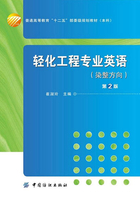
10.1 Cotton
Cotton is by far the most important textile fiber and makes up nearly 50 percent of the total weight of fibers used in the world. It is obtained from the cotton plant which grows in warm moist climates and in most parts of the world. Cotton fibers are composed largely of cellulose. Besides cellulose,raw cotton contains a number of other substances,notably waxes,pectic products and mineral substances. They can range from 4% to 12% together and are referred to as impurities by the manufacturer of cotton goods. Generally these are objectionable effects and would make it difficult to color and finish cotton fabrics satisfactorily,so it is always a first step in the art of dyeing and finishing to purify the cotton as completely as possible. ①
Cellulose is considered to be a condensation polymer formed from the glucose units. There are 3,000-5,000 glucose units joined together in natural cellulosic fibers. This corresponds to a molecular weight of 300,000-500,000.
Cotton is excellent for a multitude of purposes and has virtually universal consumer acceptance. It is used for apparel fabrics,for household or domestic goods,and for industrial applications. Cotton is also extensively used in blends with man-made fibers to achieve new combinations of properties that are not available in the fibers separately.
Cotton has some disadvantages,too. It creases and wrinkles easily. It is readily attacked by acid reagents or substances,and it is slowly affected by sunlight,causing yellowing and fiber degradation (see Table 10-2).
Table 10-2 Properties of Main Natural Fibers

continue
